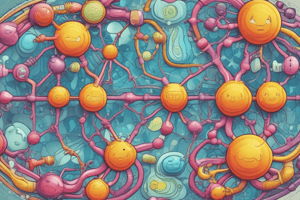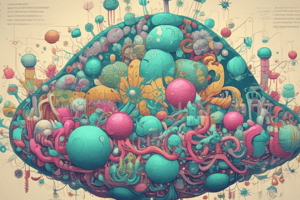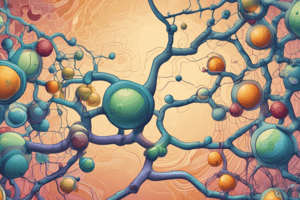Podcast
Questions and Answers
Which of the following is a primary building block for fatty acid synthesis?
Which of the following is a primary building block for fatty acid synthesis?
- Malonyl-CoA
- Glycerol
- Citrate
- Acetyl-CoA (correct)
What is the key enzyme in triglyceride breakdown?
What is the key enzyme in triglyceride breakdown?
- HMG-CoA reductase
- Fatty acid synthase
- Lipoprotein lipase
- Hormone-sensitive lipase (correct)
What is the product of fatty acid synthesis that inhibits beta oxidation?
What is the product of fatty acid synthesis that inhibits beta oxidation?
- Citrate
- Malonyl-CoA (correct)
- Glycerol
- Acetyl-CoA
What is the key enzyme in cholesterol synthesis?
What is the key enzyme in cholesterol synthesis?
What is the regulation of triglyceride metabolism by insulin?
What is the regulation of triglyceride metabolism by insulin?
What is the activate of beta oxidation?
What is the activate of beta oxidation?
What is the regulation of cholesterol synthesis by thyroid hormone?
What is the regulation of cholesterol synthesis by thyroid hormone?
What is the location of fatty acid synthesis?
What is the location of fatty acid synthesis?
What is the regulation of cholesterol synthesis by insulin?
What is the regulation of cholesterol synthesis by insulin?
What is the role of SREBP in cholesterol regulation?
What is the role of SREBP in cholesterol regulation?
Flashcards are hidden until you start studying
Study Notes
Fatty Acid Synthesis
- Occurs in the cytosol of adipose tissue and liver
- Key enzyme: fatty acid synthase (FAS)
- Acetyl-CoA is the primary building block
- Fatty acid synthesis is inhibited by:
- High levels of ATP, NADH, and acetyl-CoA
- Insulin
- Activated by:
- Insulin
- Citrate (activates acetyl-CoA carboxylase)
- High glucose levels
Beta Oxidation
- Occurs in the mitochondria
- Breakdown of fatty acids into acetyl-CoA
- Four main steps:
- Activation of fatty acids into acyl-CoA
- Transport of acyl-CoA into the mitochondria
- Beta oxidation (repative cycle of 4 reactions)
- Electron transport chain and ATP synthesis
- Inhibited by:
- Malonyl-CoA (product of fatty acid synthesis)
- ATP and NADH
- Activated by:
- Low glucose levels
- High glucagon levels
- Epinephrine
Triglyceride Metabolism
- Triglycerides (TG) are formed by esterifying glycerol with three fatty acids
- TG are stored in adipose tissue and released into the bloodstream as free fatty acids (FFA) and glycerol
- Hormone-sensitive lipase (HSL) is the key enzyme in TG breakdown
- TG metabolism is regulated by:
- Insulin (inhibits TG breakdown, promotes synthesis)
- Glucagon and epinephrine (activate TG breakdown)
- Lipoprotein lipase (LPL) breaks down TG in chylomicrons and VLDL in the bloodstream
Cholesterol Regulation
- Cholesterol is synthesized from acetyl-CoA in the liver
- Key enzyme: HMG-CoA reductase
- Cholesterol regulation is critical for maintaining proper membrane fluidity and function
- Regulation of cholesterol synthesis:
- Inhibited by:
- High cholesterol levels
- Insulin
- Activated by:
- Low cholesterol levels
- Thyroid hormone
- SREBP (sterol regulatory element-binding protein)
- Inhibited by:
- LDL receptors regulate cholesterol uptake in the liver and peripheral tissues
Fatty Acid Synthesis
- Takes place in the cytosol of adipose tissue and liver
- Fatty acid synthase (FAS) is the key enzyme
- Acetyl-CoA serves as the primary building block
- Inhibited by high levels of ATP, NADH, and acetyl-CoA, as well as insulin
- Activated by insulin, citrate, and high glucose levels
Beta Oxidation
- Occurs in the mitochondria
- Breaks down fatty acids into acetyl-CoA
- Consists of four main steps: activation of fatty acids, transport of acyl-CoA, beta oxidation, and electron transport chain and ATP synthesis
- Inhibited by malonyl-CoA, ATP, and NADH
- Activated by low glucose levels, high glucagon levels, and epinephrine
Triglyceride Metabolism
- Triglycerides are formed by esterifying glycerol with three fatty acids
- Stored in adipose tissue and released into the bloodstream as free fatty acids and glycerol
- Hormone-sensitive lipase (HSL) is the key enzyme in triglyceride breakdown
- Regulated by insulin, which inhibits triglyceride breakdown and promotes synthesis
- Glucagon and epinephrine activate triglyceride breakdown
- Lipoprotein lipase (LPL) breaks down triglycerides in chylomicrons and VLDL in the bloodstream
Cholesterol Regulation
- Synthesized from acetyl-CoA in the liver
- Key enzyme: HMG-CoA reductase
- Regulation is critical for maintaining proper membrane fluidity and function
- Inhibited by high cholesterol levels and insulin
- Activated by low cholesterol levels, thyroid hormone, and SREBP (sterol regulatory element-binding protein)
- LDL receptors regulate cholesterol uptake in the liver and peripheral tissues
Studying That Suits You
Use AI to generate personalized quizzes and flashcards to suit your learning preferences.



